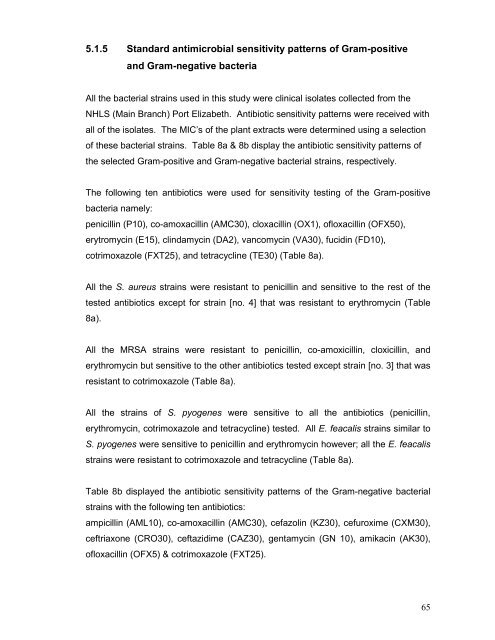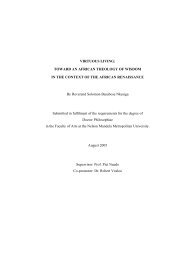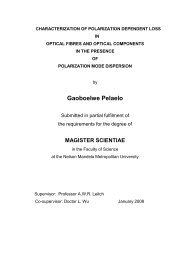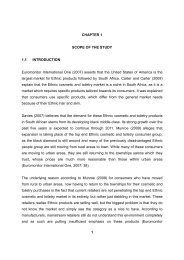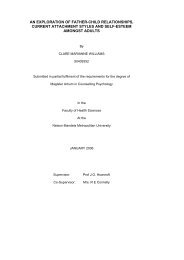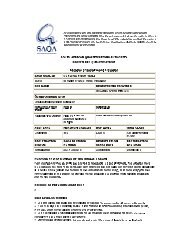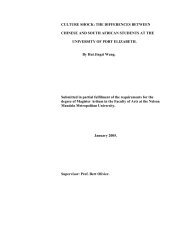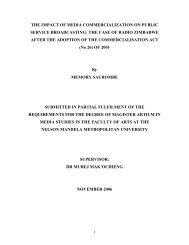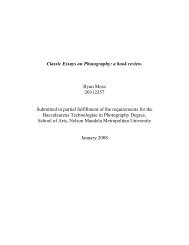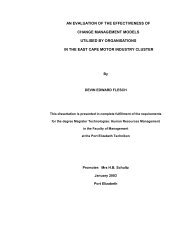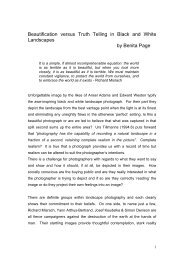an investigation into the antibacterial activities of medicinal plants ...
an investigation into the antibacterial activities of medicinal plants ...
an investigation into the antibacterial activities of medicinal plants ...
You also want an ePaper? Increase the reach of your titles
YUMPU automatically turns print PDFs into web optimized ePapers that Google loves.
5.1.5 St<strong>an</strong>dard <strong>an</strong>timicrobial sensitivity patterns <strong>of</strong> Gram-positive<br />
<strong>an</strong>d Gram-negative bacteria<br />
All <strong>the</strong> bacterial strains used in this study were clinical isolates collected from <strong>the</strong><br />
NHLS (Main Br<strong>an</strong>ch) Port Elizabeth. Antibiotic sensitivity patterns were received with<br />
all <strong>of</strong> <strong>the</strong> isolates. The MIC’s <strong>of</strong> <strong>the</strong> pl<strong>an</strong>t extracts were determined using a selection<br />
<strong>of</strong> <strong>the</strong>se bacterial strains. Table 8a & 8b display <strong>the</strong> <strong>an</strong>tibiotic sensitivity patterns <strong>of</strong><br />
<strong>the</strong> selected Gram-positive <strong>an</strong>d Gram-negative bacterial strains, respectively.<br />
The following ten <strong>an</strong>tibiotics were used for sensitivity testing <strong>of</strong> <strong>the</strong> Gram-positive<br />
bacteria namely:<br />
penicillin (P10), co-amoxacillin (AMC30), cloxacillin (OX1), <strong>of</strong>loxacillin (OFX50),<br />
erytromycin (E15), clindamycin (DA2), v<strong>an</strong>comycin (VA30), fucidin (FD10),<br />
cotrimoxazole (FXT25), <strong>an</strong>d tetracycline (TE30) (Table 8a).<br />
All <strong>the</strong> S. aureus strains were resist<strong>an</strong>t to penicillin <strong>an</strong>d sensitive to <strong>the</strong> rest <strong>of</strong> <strong>the</strong><br />
tested <strong>an</strong>tibiotics except for strain [no. 4] that was resist<strong>an</strong>t to erythromycin (Table<br />
8a).<br />
All <strong>the</strong> MRSA strains were resist<strong>an</strong>t to penicillin, co-amoxicillin, cloxicillin, <strong>an</strong>d<br />
erythromycin but sensitive to <strong>the</strong> o<strong>the</strong>r <strong>an</strong>tibiotics tested except strain [no. 3] that was<br />
resist<strong>an</strong>t to cotrimoxazole (Table 8a).<br />
All <strong>the</strong> strains <strong>of</strong> S. pyogenes were sensitive to all <strong>the</strong> <strong>an</strong>tibiotics (penicillin,<br />
erythromycin, cotrimoxazole <strong>an</strong>d tetracycline) tested. All E. feacalis strains similar to<br />
S. pyogenes were sensitive to penicillin <strong>an</strong>d erythromycin however; all <strong>the</strong> E. feacalis<br />
strains were resist<strong>an</strong>t to cotrimoxazole <strong>an</strong>d tetracycline (Table 8a).<br />
Table 8b displayed <strong>the</strong> <strong>an</strong>tibiotic sensitivity patterns <strong>of</strong> <strong>the</strong> Gram-negative bacterial<br />
strains with <strong>the</strong> following ten <strong>an</strong>tibiotics:<br />
ampicillin (AML10), co-amoxacillin (AMC30), cefazolin (KZ30), cefuroxime (CXM30),<br />
ceftriaxone (CRO30), ceftazidime (CAZ30), gentamycin (GN 10), amikacin (AK30),<br />
<strong>of</strong>loxacillin (OFX5) & cotrimoxazole (FXT25).<br />
65


